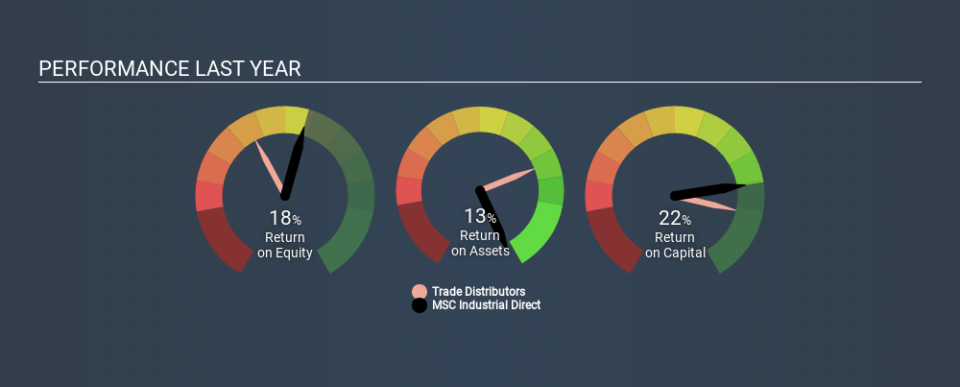Here's What MSC Industrial Direct Co., Inc.'s (NYSE:MSM) ROCE Can Tell Us

Today we are going to look at MSC Industrial Direct Co., Inc. (NYSE:MSM) to see whether it might be an attractive investment prospect. Specifically, we're going to calculate its Return On Capital Employed (ROCE), in the hopes of getting some insight into the business.
First up, we'll look at what ROCE is and how we calculate it. Next, we'll compare it to others in its industry. And finally, we'll look at how its current liabilities are impacting its ROCE.
What is Return On Capital Employed (ROCE)?
ROCE is a measure of a company's yearly pre-tax profit (its return), relative to the capital employed in the business. Generally speaking a higher ROCE is better. Overall, it is a valuable metric that has its flaws. Renowned investment researcher Michael Mauboussin has suggested that a high ROCE can indicate that 'one dollar invested in the company generates value of more than one dollar'.
How Do You Calculate Return On Capital Employed?
Analysts use this formula to calculate return on capital employed:
Return on Capital Employed = Earnings Before Interest and Tax (EBIT) ÷ (Total Assets - Current Liabilities)
Or for MSC Industrial Direct:
0.22 = US$421m ÷ (US$2.3b - US$404m) (Based on the trailing twelve months to November 2019.)
Therefore, MSC Industrial Direct has an ROCE of 22%.
See our latest analysis for MSC Industrial Direct
Is MSC Industrial Direct's ROCE Good?
ROCE is commonly used for comparing the performance of similar businesses. Using our data, we find that MSC Industrial Direct's ROCE is meaningfully better than the 9.2% average in the Trade Distributors industry. We consider this a positive sign, because it suggests it uses capital more efficiently than similar companies. Regardless of the industry comparison, in absolute terms, MSC Industrial Direct's ROCE currently appears to be excellent.
You can click on the image below to see (in greater detail) how MSC Industrial Direct's past growth compares to other companies.
It is important to remember that ROCE shows past performance, and is not necessarily predictive. ROCE can be misleading for companies in cyclical industries, with returns looking impressive during the boom times, but very weak during the busts. ROCE is, after all, simply a snap shot of a single year. Since the future is so important for investors, you should check out our free report on analyst forecasts for MSC Industrial Direct.
What Are Current Liabilities, And How Do They Affect MSC Industrial Direct's ROCE?
Current liabilities are short term bills and invoices that need to be paid in 12 months or less. The ROCE equation subtracts current liabilities from capital employed, so a company with a lot of current liabilities appears to have less capital employed, and a higher ROCE than otherwise. To counteract this, we check if a company has high current liabilities, relative to its total assets.
MSC Industrial Direct has total assets of US$2.3b and current liabilities of US$404m. As a result, its current liabilities are equal to approximately 17% of its total assets. The fairly low level of current liabilities won't have much impact on the already great ROCE.
Our Take On MSC Industrial Direct's ROCE
, There might be better investments than MSC Industrial Direct out there, but you will have to work hard to find them . These promising businesses with rapidly growing earnings might be right up your alley.
I will like MSC Industrial Direct better if I see some big insider buys. While we wait, check out this free list of growing companies with considerable, recent, insider buying.
If you spot an error that warrants correction, please contact the editor at editorial-team@simplywallst.com. This article by Simply Wall St is general in nature. It does not constitute a recommendation to buy or sell any stock, and does not take account of your objectives, or your financial situation. Simply Wall St has no position in the stocks mentioned.
We aim to bring you long-term focused research analysis driven by fundamental data. Note that our analysis may not factor in the latest price-sensitive company announcements or qualitative material. Thank you for reading.

 Yahoo News
Yahoo News 

